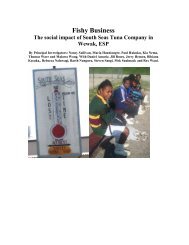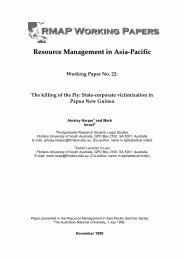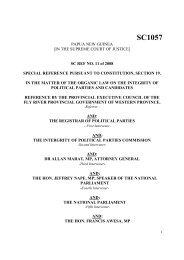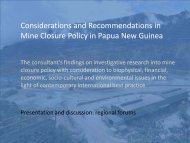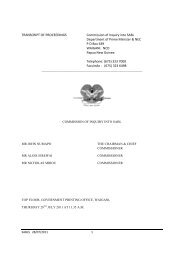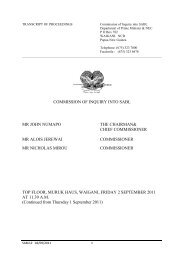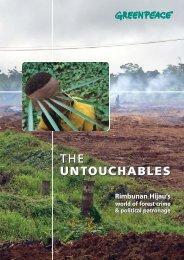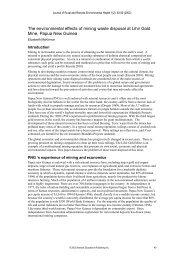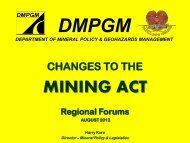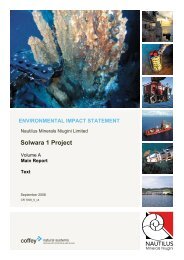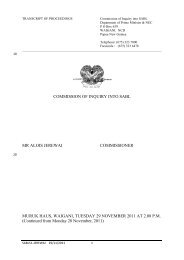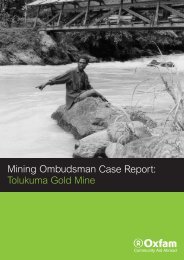A brief history of the Ramu nickel mine and the ... - Act Now!
A brief history of the Ramu nickel mine and the ... - Act Now!
A brief history of the Ramu nickel mine and the ... - Act Now!
You also want an ePaper? Increase the reach of your titles
YUMPU automatically turns print PDFs into web optimized ePapers that Google loves.
<br />
A <strong>brief</strong> <strong>history</strong> <strong>of</strong> <strong>the</strong> <strong>Ramu</strong> <strong>nickel</strong> <strong>mine</strong> <br />
<strong>and</strong> <strong>the</strong> Submarine Tailings Disposal issue <br />
<br />
1. Around January 1999 <strong>Ramu</strong> Nickel Ltd (a subsidiary <strong>of</strong> Highl<strong>and</strong>s Pacific Ltd) lodged an <br />
application for a Special Mining lease for <strong>the</strong> <strong>Ramu</strong> Nickel project <strong>and</strong> lodged <strong>the</strong> <strong>Ramu</strong> Nickel <br />
Environmental Plan 1999 for <strong>the</strong> project with <strong>the</strong> Department <strong>of</strong> Environment <strong>and</strong> Conservation. <br />
<br />
2. On 21 March 2000 <strong>the</strong> Department <strong>of</strong> Environment <strong>and</strong> Conservation approved <strong>the</strong> <strong>Ramu</strong> Nickel <br />
Environmental Plan 1999 under <strong>the</strong> repealed legislation <strong>the</strong> Environmental Planning <strong>Act</strong> <br />
(repealed). <br />
<br />
3. On 26 July 2000 <strong>the</strong> Special Mining Lease (“SML”) was granted to <strong>Ramu</strong> Nickel Ltd. <br />
<br />
4. The SML <strong>and</strong> Environmental Plan Approval was subject to numerous conditions including that <br />
<strong>the</strong> lessee shall comply with all <strong>the</strong> relevant legislation applicable to <strong>the</strong> lease including that <br />
administered by <strong>the</strong> department <strong>of</strong> Mining, Office <strong>of</strong> Environment <strong>and</strong> Conservation <strong>and</strong> <strong>the</strong> <br />
Bureau <strong>of</strong> Water Resources. <br />
<br />
5. On 1 January 2004, <strong>the</strong> Environment <strong>Act</strong> 2000 came into force <strong>and</strong> amongst o<strong>the</strong>r things <br />
repealed <strong>the</strong> Environmental Planning <strong>Act</strong>, <strong>the</strong> Water resources <strong>Act</strong> <strong>and</strong> <strong>the</strong> Environmental <br />
Contaminants <strong>Act</strong>. <br />
<br />
6. The <strong>Ramu</strong> Nickel Environmental Plan 1999 Approval itself was technically saved however <br />
pursuant to section 136 <strong>of</strong> <strong>the</strong> Environment <strong>Act</strong> 2000. <br />
<br />
7. In 2004 however <strong>the</strong> China Metallurgical Construction Company (“MCC”), a Chinese State‐owned <br />
steel company started negotiations to fully finance <strong>the</strong> operations, including rights to construct, <br />
operate <strong>and</strong> secure <strong>of</strong>f take arrangements for <strong>the</strong> proposed <strong>Ramu</strong> Nickel <strong>mine</strong>. <br />
<br />
8. On 9 February 2004 a framework agreement was signed in Beijing by MCC, <strong>Ramu</strong> Nickel Limited, <br />
Mineral Resources Development Company Limited <strong>and</strong> <strong>the</strong> Independent State <strong>of</strong> Papua New <br />
Guinea. No any l<strong>and</strong>owners were consulted or involved. The framework agreement states that <br />
those parties agree in good faith to form a Joint Venture to develop <strong>the</strong> project <strong>and</strong> that <strong>the</strong> <br />
“l<strong>and</strong>owners” would be a party to <strong>the</strong> Joint Venture. The agreement records that that <strong>Ramu</strong> <br />
Nickel Limited <strong>and</strong> <strong>the</strong> State shall give <strong>the</strong> <strong>mine</strong> <strong>and</strong> all exploitation rights to MCC in exchange <br />
for a 15% interest(to be divided 8.7% to Highl<strong>and</strong>s Pacific <strong>and</strong> 6.3% to <strong>the</strong> State) <strong>and</strong> that MCC <br />
would be responsible for <strong>the</strong> 100% funding <strong>of</strong> <strong>the</strong> project. <br />
<br />
9. A Joint Venture Agreement <strong>and</strong> also a Mining Development Contract was signed between MCC, <br />
<strong>Ramu</strong> Nickel Limited <strong>and</strong> <strong>the</strong> Independent State <strong>of</strong> Papua New Guinea in 2005 <strong>and</strong> <strong>the</strong> SML was <br />
transferred from <strong>Ramu</strong> Nickel Limited to MCC in or around October 2005. <br />
<br />
10. A company was registered by its 100% owner MCC to manage <strong>and</strong> operate <strong>the</strong> <strong>Ramu</strong> Nickel <br />
<strong>mine</strong> project. <br />
<br />
11. The construction <strong>of</strong> <strong>the</strong> <strong>mine</strong> commenced in 2008. <br />
<br />
12. When operational, <strong>the</strong> <strong>Ramu</strong> Nickel <strong>mine</strong> will be a series <strong>of</strong> open cut <strong>mine</strong> pits <strong>and</strong> a <br />
beneficiation plant to produce ore slurry at Kurumbrukari in Madang Province. A slurry pipeline <br />
approximately 134km long will transport <strong>the</strong> ore slurry from <strong>the</strong> Kurubrukari <strong>mine</strong> site <br />
eastwards to <strong>the</strong> refinery plant at Basamuk Bay on <strong>the</strong> Rai Coast. The refinery plant will produce <br />
<strong>nickel</strong> metal <strong>and</strong> a cobalt salt product using acid pressure leaching technology. <br />
<br />
Page 1
<br />
<br />
The <strong>Ramu</strong> Nickel Environmental Plan 1999 <strong>and</strong> Environmental Approval <br />
<br />
13. The <strong>Ramu</strong> Nickel Environmental Plan 1999 was prepared by NSR Environmental Consultants Pty <br />
Ltd, an Australian company that has advised companies on 25 ocean disposal projects clustered <br />
in 9 countries being Indonesia, Papua New Guinea, New Caledonia, <strong>the</strong> Philippines, Chile, Fiji, <strong>the</strong> <br />
Solomon Isl<strong>and</strong>s, Cuba <strong>and</strong> Canada. <br />
<br />
14. According to <strong>the</strong> <strong>Ramu</strong> Nickel Environmental Plan 1999, <strong>the</strong> <strong>mine</strong> will dump 5 million tones <strong>of</strong> <br />
hot tailings into Astrolabe Bay each year for <strong>the</strong> life <strong>of</strong> <strong>the</strong> <strong>mine</strong> which is estimated at 20 years, <br />
totaling 100 million tones <strong>of</strong> tailings. The tailings will consist <strong>of</strong> mainly sediment <strong>and</strong> fines which <br />
will contain among o<strong>the</strong>r substances high levels <strong>of</strong> heavy metals including but not limited to <br />
manganese, chromium, <strong>nickel</strong> <strong>and</strong> mercury. It will also contain high levels <strong>of</strong> ammonia <strong>and</strong> <br />
sulphuric acid. The <strong>mine</strong> will additionally dump waste rock <strong>and</strong> soil directly into <strong>the</strong> sea at <br />
Basamuk Bay during <strong>the</strong> construction <strong>and</strong> life <strong>of</strong> <strong>the</strong> <strong>mine</strong> as well as raw sewerage from 2500 <br />
people for 30 months. <br />
<br />
Lu<strong>the</strong>ran church investigation <br />
<br />
15. Because <strong>of</strong> concerns as to <strong>the</strong> environmental effects <strong>of</strong> <strong>the</strong>se tailings <strong>and</strong> waste disposal, in late <br />
2000 <strong>the</strong> Evangelical Lu<strong>the</strong>ran Church <strong>of</strong> Papua New Guinea commissioned <strong>the</strong> Mineral Policy <br />
Institute to undertake an independent review <strong>of</strong> aspects <strong>of</strong> <strong>the</strong> <strong>Ramu</strong> Nickel Environmental Plan <br />
1999 as complied by Natural Research Systems (“NSR”). This was motivated by concerns for <strong>the</strong> <br />
well being <strong>of</strong> <strong>the</strong> Madang Community <strong>and</strong> an underlying desire for both development <strong>and</strong> <br />
environmental protection in Madang province <br />
<br />
16. The selection <strong>of</strong> <strong>the</strong> team for this review was based on two criteria; independence <strong>and</strong> expertise. <br />
Consultants were required that had a track record <strong>of</strong> excellence in research in <strong>the</strong> region, who <br />
had experience in environmental impact assessments <strong>and</strong> who could talk authoritatively on <br />
complementary aspects <strong>of</strong> <strong>the</strong> <strong>Ramu</strong> Environmental Plan that involved deep Sea Tailings <br />
Disposal. Independence was crucial, individuals were needed who had not worked for <strong>the</strong> <br />
mining industry in Papua New Guinea <strong>and</strong> who were not aligned with “green” groups in o<strong>the</strong>r <br />
parts <strong>of</strong> <strong>the</strong> world. <br />
<br />
17. After a search for suitable c<strong>and</strong>idates , three e<strong>mine</strong>nt scientists from Australian institutions were <br />
employed being <br />
<br />
a) Dr John Luick, an oceanographer <strong>and</strong> Lecturer in Ocean wave Theory <strong>and</strong> Scientific Consultant to <br />
<strong>the</strong> National Tidal facility at The Flinders University <strong>of</strong> South Australia. <br />
b) Dr Gregg Brunskill, a marine geochemist <strong>and</strong> research fellow at <strong>the</strong> Australian Institute <strong>of</strong> Marine <br />
Science in Townsville Australia <br />
c) Dr Marcus Sheaves, a marine ecologist <strong>and</strong> Lecturer at James Cook University in Townsville <br />
Australia. <br />
<br />
26 Dr Phil Shearman, an Ecologist <strong>and</strong> <strong>the</strong> Director <strong>of</strong> <strong>the</strong> Remote Sensing Centre in <strong>the</strong> Biology <br />
Department at <strong>the</strong> School <strong>of</strong> Natural <strong>and</strong> Physical Sciences at <strong>the</strong> University <strong>of</strong> Papua New <br />
Guinea was chosen to author <strong>the</strong> final report <strong>and</strong> analise <strong>the</strong> three separate findings <strong>and</strong> reports <br />
<strong>of</strong> <strong>the</strong> scientists. <br />
<br />
27 The fundamental findings <strong>of</strong> <strong>the</strong> reports were that NSR had compiled a well presented but fatally <br />
flawed case for <strong>the</strong> discharge <strong>of</strong> <strong>mine</strong> tailings via a submarine pipe into Astrolabe Bay <strong>and</strong> that <br />
fur<strong>the</strong>r that <strong>the</strong>re can be no doubt that disturbance on <strong>the</strong> scale <strong>of</strong> a Submarine Tailings Disposal <br />
operation will have significant biological impact. <br />
<br />
28 The report found If <strong>the</strong> dumping is to proceed, <strong>the</strong>n <strong>the</strong> potential consequences should be <br />
weighed against <strong>the</strong> environmental degradation which could result from both Submarine <br />
Page 2
<br />
Tailings Disposal <strong>and</strong> o<strong>the</strong>r tailings disposal methods. The Government <strong>of</strong> Papua New Guinea <br />
did not have this option in regard to <strong>the</strong> <strong>Ramu</strong> Nickel Project as <strong>the</strong> Environmental Plan <br />
prepared by NSR gave no indication <strong>of</strong> <strong>the</strong> likely impacts or risks associated with <strong>the</strong> proposal <br />
<strong>and</strong> did not thoroughly exa<strong>mine</strong> alternatives to marine discharge. <br />
<br />
29 Essentially <strong>the</strong> review found that <strong>the</strong> behavior <strong>of</strong> tailings discharged into Astrolabe Bay was not <br />
adequately explained in <strong>the</strong> NSR Environmental Plan. While NSR claim that tailings will be <br />
deposited safely on <strong>the</strong> deep floor <strong>of</strong> <strong>the</strong> Vitiaz Basin, on <strong>the</strong> basis <strong>of</strong> <strong>the</strong>ir own date, this is <br />
extremely improbable. The review found overall sheds significant doubt on NSR’s predictions <br />
about <strong>the</strong> biologiocal impacts <strong>of</strong> Submarine Tailings Disposal in Astrolabe Bay. <br />
<br />
Events after <strong>the</strong> Lu<strong>the</strong>ran Report <br />
<br />
30 The project was essentially put on hold from 2001 to 2006 after <strong>the</strong> SML had been transferred to <br />
MCC. Given <strong>the</strong> announcement that <strong>the</strong> <strong>Ramu</strong> Nickel project was to start, people in Madang <br />
started expressing concerns about it. An update forum was held at Divine Word on Monday 14 <br />
August 2006 <strong>and</strong> <strong>the</strong>re, <strong>the</strong> Lu<strong>the</strong>ran Church presented to Sir Peter Barter (<strong>the</strong> <strong>the</strong>n Member for <br />
Madang, Minister <strong>and</strong> member <strong>of</strong> NEC) a copy <strong>of</strong> <strong>the</strong>ir report commissioned in 2000/2001. Sir <br />
Peter Barter described <strong>the</strong> report as credible <strong>and</strong> assured <strong>the</strong> church representatives that <strong>the</strong> <br />
issue would be looked at seriously. The people waited. <br />
<br />
31 On 9 February 2007, a report was published in <strong>the</strong> Post Courier newspaper by a Clement <br />
Kun<strong>and</strong>i Victo, which highlighted <strong>the</strong> dangerous effects <strong>of</strong> <strong>the</strong> proposed dumping <strong>of</strong> <strong>the</strong> tailings <br />
on <strong>the</strong> fisheries resources in Madang. There was no response from Government. <br />
<br />
32 On 14 January 2008, it was reported that 1.2 million Lu<strong>the</strong>rans (<strong>the</strong> Plaintiffs <strong>and</strong> people at <br />
Basamuk are Lu<strong>the</strong>rans) had petitioned <strong>the</strong> Somare Government to seriously look at <strong>the</strong> <br />
environmental impact <strong>of</strong> <strong>the</strong> <strong>Ramu</strong> Nickel <strong>mine</strong>, <strong>and</strong> that that action had been taken after Prime <br />
Minister Michael Somare rejected three attempts in 2007 by <strong>the</strong> ELCPNG head <strong>the</strong> late Bishop <br />
Dr Wesley Kigasung to receive <strong>the</strong> environmental study commissioned by <strong>the</strong> Church. It reported <br />
that Dr Kigasung had wrote to Sir Michael, his deputy <strong>and</strong> Mining Minister Dr Puka Temu <strong>and</strong> <br />
Environment <strong>and</strong> Conservation Minister Benny Allen to accept <strong>the</strong> report <strong>and</strong> seriously consider <br />
<strong>the</strong> <strong>mine</strong>’s pollution impact to <strong>the</strong> sea. Former Member <strong>of</strong> Parliament Sir Peter Barter joined <br />
with Dr Kisagung <strong>and</strong> requested that <strong>the</strong>se politicians meet personally with Dr Kisagung. There <br />
was no response from <strong>the</strong> Ministers. <br />
<br />
33 On 7 April 2008, a Newspaper report in <strong>the</strong> Post Courier stated that <strong>the</strong> Fisheries Minister Ben <br />
Semri had said that he would not allow <strong>mine</strong> tailings from <strong>the</strong> <strong>Ramu</strong> Nickel project to enter PNG <br />
waters <strong>and</strong> said that he totally opposed <strong>the</strong> submarine tailings disposal <strong>and</strong> it would be a major <br />
environmental disaster if true. He was reported as stating in parliament that <strong>the</strong> NFA <br />
documented <strong>and</strong> strongly opposed <strong>the</strong> idea <strong>and</strong> stated that “NFA will not be irresponsible to let <br />
destruction or pollution enter PNG seas.” <br />
<br />
34 On <strong>the</strong> 10 th <strong>of</strong> April 2008, a Post Courier newspaper report recorded Minister Semri as stating <br />
that 30,000 people in <strong>the</strong> country would lose <strong>the</strong>ir jobs <strong>and</strong> fish exports could be rejected if <strong>the</strong> <br />
waters <strong>of</strong> PNG were polluted with mining waste <strong>and</strong> that <strong>the</strong> NFA opposed any toxic form <strong>of</strong> <br />
tailings. <br />
<br />
35 On 11 April 2008, <strong>the</strong> Post Courier reported that <strong>the</strong> opposition asked <strong>the</strong> government a series <br />
<strong>of</strong> questions during a press conference relating to environmental damage <strong>and</strong> asked <strong>and</strong> asked <br />
<strong>the</strong> Ministers <strong>of</strong> Mining, Environment <strong>and</strong> Fisheries to state what <strong>the</strong>ir positions were with <br />
regard to <strong>the</strong> much debated Basamuk Tailings. <br />
<br />
36 On 18 April 2008, <strong>the</strong> Post Courier reported that <strong>the</strong> catholic Bishops Conference issued a <br />
statement saying <strong>the</strong>y joined <strong>the</strong> increasing number <strong>of</strong> groups <strong>and</strong> individuals calling for a <br />
Page 3
<br />
review <strong>of</strong> <strong>the</strong> environmental issues involving <strong>the</strong> <strong>Ramu</strong> Nickel project <strong>and</strong> stated that <strong>the</strong> <br />
submarine tailings disposal plan must not be allowed to go ahead. <br />
<br />
37 On 13 May 2008, <strong>the</strong> Post Courier reported that <strong>the</strong> Head <strong>of</strong> <strong>the</strong> Lu<strong>the</strong>ran Church <strong>of</strong> PNG, Dr <br />
Kisagung described <strong>the</strong> prolonged silence <strong>of</strong> Sir Michael Somare on <strong>the</strong>ir report into <strong>the</strong> effects <br />
<strong>of</strong> <strong>the</strong> <strong>Ramu</strong> Nickel <strong>mine</strong> waste on marine life in Madang Province as a matter <strong>of</strong> great concern <br />
not only for <strong>the</strong> church but also for <strong>the</strong> country as a whole. <br />
<br />
Scottish Association <strong>of</strong> Marine Science investigation <br />
<br />
38 Eventually Dr Puka Temu, <strong>the</strong> Deputy Prime Minister <strong>and</strong> Minister for Mines, <strong>the</strong>n announced in <br />
June 2008 that <strong>the</strong> government had commissioned a study to be conducted by <strong>the</strong> Scottish <br />
Association <strong>of</strong> Marine Science to study <strong>the</strong> environmental impact <strong>of</strong> <strong>the</strong> <strong>Ramu</strong> Nickel project on <br />
<strong>the</strong> Basamuk area., following widespread concerns over <strong>the</strong> proposed deep sea tailings disposal <br />
system (see newspaper report). The Minister said all stakeholders including <strong>the</strong> Madang <br />
Provincial Government <strong>and</strong> L<strong>and</strong>owners, particularly those at Basamuk, would be given a full <br />
report on <strong>the</strong> findings after <strong>the</strong> study was completed. The Scottish Association <strong>of</strong> Marine Science <br />
was actually tasked to (1) provide a report on <strong>the</strong> effects <strong>of</strong> <strong>the</strong> submarine tailings disposal <br />
operations at Lihir <strong>and</strong> Misima, (2) to provide a baseline study as to <strong>the</strong> marine environment at <br />
Basamuk in Madang Province <strong>and</strong> (3) provide a set <strong>of</strong> guidelines for submarine tailings disposal <br />
in Papua New Guinea. <br />
<br />
39 The Scottish Institute <strong>of</strong> Marine Science <strong>the</strong>n in November 2008 ran a Deep Sea Tailing <br />
Placement Conference in Madang which according to a Post Courier report dated 11 November <br />
2008, ended with calls for <strong>the</strong> National Government not to pursue <strong>the</strong> submarine tailings <br />
disposal option until all uncertainties were resolved. This was in response to <strong>the</strong> presentation <strong>of</strong> <br />
Draft guidelines <strong>and</strong> criteria generally for deep sea tailings disposal. The findings <strong>of</strong> <strong>the</strong> team as <br />
to <strong>the</strong> effects <strong>of</strong> tailings was NOT presented at all, as it was not completed nor intended to be so <br />
presented. The newspaper report also recorded <strong>the</strong> Governor <strong>of</strong> Madang as saying that <strong>the</strong> <br />
people are concerned <strong>and</strong> not satisfied with <strong>the</strong> current underst<strong>and</strong>ing <strong>of</strong> impacts on our <br />
livelihood <strong>and</strong> life <strong>and</strong> are not willing to accept <strong>the</strong> uncertainty <strong>of</strong> risks posed by deep sea <br />
tailings disposal. <br />
<br />
40 As at March 2010 <strong>the</strong> Final report by <strong>the</strong> Scottish Institute <strong>of</strong> Marine Science had not been <br />
produced <strong>and</strong> made public by <strong>the</strong> government. However <strong>the</strong> government approved <strong>the</strong> tailings <br />
disposal without considering <strong>the</strong> final report. <br />
<br />
41 The government has also approved coral blasting to make a route for <strong>the</strong> submarine tailings <br />
pipeline. It appears Telikom PNG was shocked to hear about <strong>the</strong> blasting. <br />
<br />
Telikoms concerns <br />
<br />
42 Telikom PNG <strong>and</strong> Pipe International are laying a new Fibre Optic Submarine Cable System <br />
between Sydney, Madang <strong>and</strong> Guam. This cable system is designed to be <strong>the</strong> principal gateway <br />
to <strong>the</strong> country for voice <strong>and</strong> internet traffic <strong>and</strong> through it will pass <strong>the</strong> majority <strong>of</strong> <strong>the</strong> country’s <br />
e‐business as well as tele‐medicine <strong>and</strong> education data. The cable laying into <strong>and</strong> out <strong>of</strong> Madang <br />
was completed in 2009. Telikom PNG is extremely concerned about <strong>the</strong> stated plan to place 5 <br />
million tonnes a year totaling 100 million tones <strong>of</strong> tailing waste on <strong>the</strong> seabed in Basamuk Bay, <br />
as it could leading to conditions for a future slide <strong>of</strong> heaped tailings down <strong>the</strong> submarine slope <br />
leading to a break in <strong>the</strong> cable. Based on available science <strong>and</strong> reports, a report was compiled <br />
which sets out Telikom PNG’s main concerns <strong>and</strong> <strong>the</strong> basis upon which <strong>the</strong> concerns are founded <br />
[link to pdf files <strong>of</strong> two pages from <strong>the</strong> report]. <br />
<br />
43 Even on MCC’s own predictions, that <strong>the</strong> tailings will slide down a slope in a continuous coherent <br />
flow to deeper water, <strong>the</strong> risk <strong>of</strong> a massive turbidity current being triggered by a tectonic event <br />
Page 4
<br />
will be increased. In <strong>the</strong>ir Environmental Plan by NSR, terrestrial <strong>and</strong> seabed l<strong>and</strong>slides, <strong>and</strong> <br />
earthquakes are considered a real threat <br />
<br />
44 Such a turbidity current may be capable <strong>of</strong> breaking <strong>and</strong> washing away a section <strong>of</strong> <strong>the</strong> cable <br />
system. A similar turbidity current, generated by a tectonic event in <strong>the</strong> Luzon Strait in 2006 <br />
travelled 150 kms <strong>and</strong> broke a number <strong>of</strong> cables in <strong>the</strong> process. <br />
<br />
45 If a break does occur, this would cause significant dislocation to PNG’s telecommunications <br />
services while a specialist repair ship was brought to PNG to recover <strong>and</strong> replace <strong>the</strong> cable. <br />
Apart from <strong>the</strong> specific cost <strong>of</strong> <strong>the</strong> repair operation, <strong>the</strong> cost to <strong>the</strong> country in down‐time would <br />
also be significant. <br />
<br />
46 Given Telikom PNG’s concerns <strong>the</strong>y sent a letter in January to Dr Wang, <strong>the</strong> Technical Director <strong>of</strong> <br />
MCC Ltd <strong>and</strong> expressed <strong>the</strong>ir concerns, enclosing <strong>the</strong>ir report <strong>and</strong> requesting a meeting. Telikom <br />
met with Dr Wang <strong>and</strong> he stated that <strong>the</strong>y were reviewing <strong>the</strong>ir tailings disposal options <strong>and</strong> <br />
disposal sites <strong>and</strong> would keep Telikom informed as to <strong>the</strong>ir progress. <br />
<br />
47 Telikom were not contacted again by Dr Wang or anyone from MCC, so <strong>the</strong>y were very surprised <br />
to see <strong>the</strong> newspapers reporting that MCC was to commence coral blasting. <br />
<br />
48 In addition to <strong>the</strong> potential break in <strong>the</strong> cable Telikom are extremely concerned that <strong>the</strong> blasting <br />
program announced by MCC so as to facilitate <strong>the</strong> laying <strong>of</strong> <strong>the</strong> outfall pipe will adversely impact <br />
or disrupt <strong>the</strong> operations <strong>of</strong> <strong>the</strong> telecommunications cable. <br />
<br />
49 As <strong>of</strong> March 2010 <strong>the</strong> Scottish Association for Marine Science, through Dr Tracy Shimmield, <strong>the</strong> <br />
team leader for <strong>the</strong> report, stated that <strong>the</strong> draft final report was with MRA <strong>and</strong> <strong>the</strong> department <br />
<strong>of</strong> Environment <strong>and</strong> Conservation for comments <strong>and</strong> <strong>the</strong>n once <strong>the</strong> comments have been <br />
communicated to her, <strong>the</strong> Final report will be sent to <strong>the</strong> department <strong>of</strong> Environment <strong>and</strong> <br />
Conservation. <br />
<br />
Arguments against allowing STD <br />
<br />
50 The government is allowing MCC to go ahead with its proposed deep sea tailings disposal plan <br />
despite <br />
<br />
a) There being in existence a credible, unchallenged <strong>and</strong> independent report compiled by 4 <br />
individual reputable marine scientists that essentially finds <strong>the</strong>re will be a lot <strong>of</strong> environmental <br />
harm if <strong>the</strong> tailings dumping goes ahead <strong>and</strong> that <strong>the</strong> Environmental Plan <strong>of</strong> <strong>the</strong> First Defendant <br />
is fatally flawed, <br />
b) Objection by <strong>the</strong> National Fisheries Authority to <strong>the</strong> dumping as it will endanger fish resources <br />
c) Well known findings by <strong>the</strong> World Bank Extractive Industry Report in 2003 that “Submarine <br />
Tailings Disposal should not be used until balanced <strong>and</strong> unbiased research, accountable to <br />
balanced stakeholder management, demonstrates its safety. Whatever <strong>the</strong> outcome <strong>of</strong> <strong>the</strong> <br />
research, STD <strong>and</strong> riverine tailings disposal should not be used in areas such as coral reefs that <br />
have important ecological functions or cultural significance or in coastal waters used for <br />
subsistence purposes.” <br />
d) The Government not having received <strong>and</strong> considered <strong>and</strong> made available for public consultation <br />
<strong>the</strong> independent report it commissioned in response to community concerns on deep sea <br />
tailings disposal <br />
e) Serious concerns by Telikom as to <strong>the</strong> safety <strong>of</strong> its new cables which are <strong>the</strong> future <strong>of</strong> e‐<br />
communication in PNG <br />
f) The l<strong>and</strong> disputes not being finalized <strong>and</strong> no proper consultation with l<strong>and</strong>holders or disputing <br />
claimants, effectively depriving <strong>the</strong>m <strong>of</strong> proper consultation <strong>and</strong> negotiations over <strong>the</strong>ir l<strong>and</strong>, <br />
<strong>and</strong> <br />
g) There being in existence alternative means <strong>of</strong> tailings disposal that would not pose such an <br />
ecological risk. <br />
Page 5



